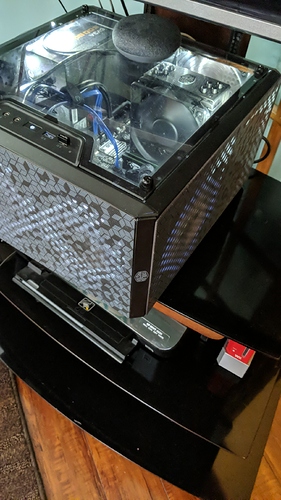TLDR: Do it if your system has grown large enough. It’s the ducks guts.
This isn’t a tutorial, just observations on the process and effect.
I see a lot of questions about how to do this and few discussions of quantitative/qualitative benefits. So I’d like to address that.
I have been running on a pi 3B for over a year. During that time I’ve added a fair number of devices, sensors, scripts and automations. I don’t think my HA server is that ‘large’ but here are some quantitative stats:
Plus about 5000 lines of Lovelace config.
I did have to move to MariaDB instead of the standard SQL database due to constant corruption of the database but other than that, I did not think my pi was performing too badly. Automations mostly ran when they should. Sensors mostly updated when they should.
I say mostly because the large amount of data the Glances component (monitoring my other pi used as a GPIO to MQTT bridge) would regularly vomit up would occasionally fail and I’d get warnings in the log.
Config checks and restarts were measured in minutes.
There were always many “component xx is taking longer than 10 sec to set up” warnings. Some components would actually fail to set up correctly (looking at you, iTach remote) and only partial control/automation was possible of devices that depended on this.
It eventually sank in that I needed to upgrade.
I purchased a new XCY core i7 4610Y mini PC with 8GB of RAM for only slightly more than you can get a Celeron NUC for. I had a spare 128GB Samsung SSD so that made a difference but still, NUC prices are way too high for what you get. Power consumption is 11W for an idle i7 4610Y. So comparable with the pi. The i7 4500U uses 15W at idle, also an option. These processors benchmark a lot faster than the Celerons.
I retained the existing Pi as another GPIO to MQTT bridge as there were switches attached to the GPIO. No rewiring was necessary I just wrote the appropriate config file for flyte’s python script and ran that in a ve on raspbian lite.
I chose to go the easy route and burned the NUC image to my SSD in an external SATA HDD enclosure with Etcher. Removed it. Installed it in the new PC and on power up was soon greeted with the very promising view of a nearly empty HA web page. Not bad for a not actually a NUC.
I chose this route as I don’t need access to the host OS. Everything I want this server to do (Grafana, MQTT, Motioneye, and more) can be done from within Hassio and its addons. If you want access to the host OS to do fancy shit, use the documented Docker on Ubuntu server LTS method.
It took very little time to set up SSH and SAMBA, copy across my latest snapshot and restore from it.
Everything appeared to be well!
Almost…
My HA local timezone was correct but he underlying HassOS had not picked up my local timezone. I won’t bore you with the details (time dependant templates and SSL not working) but performing a HA update (fortuitously available on at least a by-weekly basis!) fixed the problem. There are other ways to do this if you find you are in the same boat. Ask me how.
Actually dont. I dont know because I did not have to. I just know it is possible and what you need and where to ask ‘how’.
Now.
Now configuration checks dont let me get up out of my chair much less make a cup of tea (as they used to). Seriously, 2 to 3 seconds and it’s done.
Now I smile when I see and hear these alerts on my phone when I restart:
Last restart took 12 seconds. Compared to up to 5 minutes before the upgrade this is fantastic.
My start up log contains nothing but 3 warnings about custom components not being tested.
I can view my (still image capture based) cameras for as long as I want without the view disappearing (used to happen after about 10-20 seconds on the pi).
The only downside I’ve noticed:
Panels with 30+ mini graphs that used to take a minute or so to load make my web browser unresponsive for 2-3 seconds while the deluge of data comes in. At least for the first time they are loaded - after that only the cache has to be updated and responsiveness is fine.
In short, I’m extremely happy with the upgrade. If you are suffering from the symptoms outlined above, don’t delay, upgrade today.




